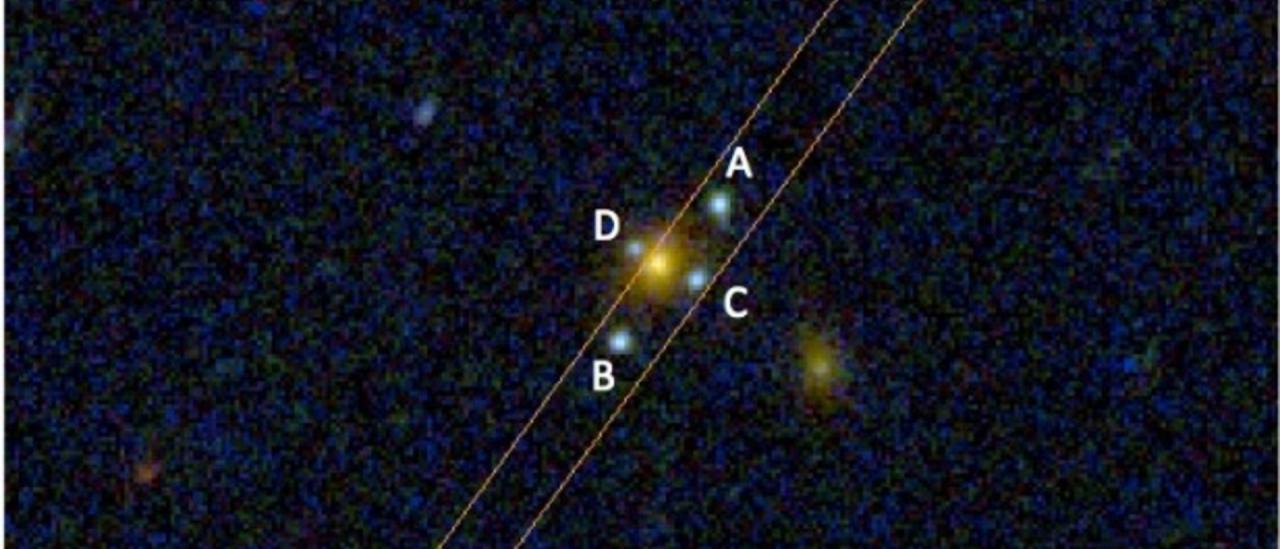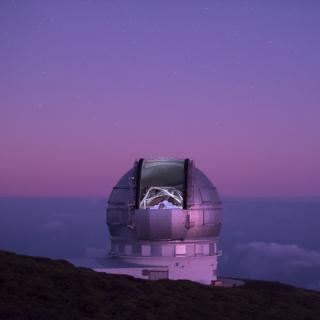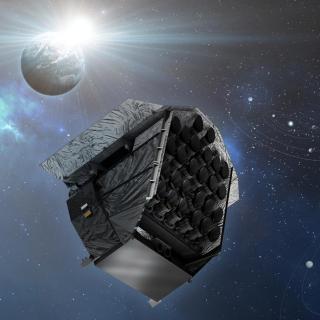One of the most striking conclusions of Albert Einstein's theory of general relativity is that the trajectory of light curves in the presence of matter. This effect can be observed in the case of light emitted by a distant galaxy, when its light passes close to another galaxy on its way to the observer. The phenomenon is known as gravitational lensing, because it is comparable to the deviation of light rays by the classic glass lenses. Similarly, gravitational lenses act like magnifying glasses that change the size, shape, and intensity of the image of the distant object.
Depending on the degree of alignment of the two sources, multiple images of the distant source can be observed, such as four separate images in the form of a cross (hence the name "Einstein's cross"), rings, or arcs. It is in general extremely difficult to spot a gravitational lens, because the separation between the images produced by the lens is usually very small, requiring high-resolution images to see them. It was precisely analyzing Hubble Space Telescope high-resolution images that it was possible to locate an asterism that looked like a new example of Einstein cross.
An exceptional discovery
However, spotting four points of light in the shape of a cross positioned around a galaxy does not assure us that it is a lens, we must show that the 4 images belong to the same object. To do this spectroscopic observations are needed. For this reason, a team of Italian scientists led by Daniela Bettoni of the Padova Observatory and Riccardo Scarpa of the IAC, decided to observe spectroscopically with GTC this alleged lens. According to Scarpa, “the result could not have been better. The atmosphere was very clean and with minimum turbolence (seeing), which allowed us to clearly separate the emission of three of the four images. The spectrum immediately gave us the answer we were looking for, the same emission line due to ionized hydrogen appeared in all three spectra at the same wavelength. There could be no doubt that it was actually the same source of light”.
A new Einstein cross had been discovered, named J2211-0350 according to its coordinates on the sky. The object acting as a lens turns out to be an elliptical galaxy located at a distance of approximately 7 billion light years (z = 0.556), while the source is at least 20 billion light years away (z = 3.03). "Normally the source is a quasar, it was with great surprise that we realized the source in this case was another galaxy, in fact a galaxy with very intense emission lines which indicates it is a young object still forming large amounts of stars", explain Bettoni. Quite an achievement for GTC, considering only another lens of this type was known.
New research tool
Thanks to these new observations, presented in the “Astrophysical Journal Letter”, astronomers now have one more tool to investigate the Universe. Gravitational lenses are important because they allows the study of the Universe in a unique way, because the light of the different images, initially the same light, follows different paths in the Universe and any spectral differences must be due to the material that is between us and the source. Moreover, if the source is variable we can see a time delay (one image illuminates before the others), which provides valuable information about the shape of the Universe.
Of course, the mass of the lens responsible for bending the light can be accurately derived, providing an important independent method to weight galaxies. Finally, as with a normal glass lens, the gravitational lens concentrates toward us the light from the source, making it possible to see intrinsically unreachable objects. In this case it could be calculated that the source is 5 times brighter than it would be without the lens.
Article: Daniela Bettoni, Renato Falomo, Riccardo Scarpa, Mattia Negrello, Alessando Omizzolo, Romano L. M. Corradi, Daniel Reverte y Benedetta Vulcani. “A New Einstein Cross Gravitational Lens of a Lyman-break Galaxy”, The Astrophysical Journal Letters, Volume 873, Number 2. DOI:10.3847/2041-8213/ab0aeb
Contact GTC/IAC: Riccardo Scarpa (riccardo.scarpa [at] gtc.iac.es (riccardo[dot]scarpa[at]gtc[dot]iac[dot]es))



